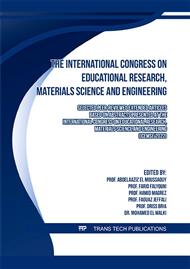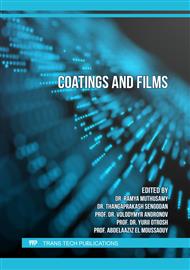[1]
F.C. Jiang, Congxin Xia, Y.M. Liu, S.Y. Wei, Built-in electric field effect on the hydrogenic donor impurity in wurtzite InGaN quantum dot, Physica E 40 (2008) 2714–2719.
DOI: 10.1016/j.physe.2007.12.020
Google Scholar
[2]
C.M. Duque, M.G. Barseghyan, C.A. Duque, Donor impurity in vertically-coupled quantum-dots under hydrostatic pressure and applied electric field, Eur. Phys. J. B 73 (2010) 309–319.
DOI: 10.1140/epjb/e2009-00433-7
Google Scholar
[3]
Yu-Han Liang, Jun-Han Huang, Neng-Chieh Chang, Chuan-Pu Liu, Designing various self-assembled ZnOx quantum dots/islands on silicon with distinctive characteristics by magnetron sputter, Cryst. Growth Des. 9 (2009) 2021–2025. 304.
DOI: 10.1021/cg8014018
Google Scholar
[4]
M. Cristea, A. Radu, E.C. Niculescu, Electric field effect on the third-order nonlinear optical susceptibility in inverted core–shell nanodots with dielectric confinement, J. Lumin. 143 (2013) 592–599.
DOI: 10.1016/j.jlumin.2013.06.022
Google Scholar
[5]
M. Chnafi, L. Belamkadem, O. Mommadi, R. Boussetta, M. El Hadi, A. El Moussaouy and C. Duque, Hydrostatic pressure and temperature effects on spectrum of an off-center single dopant in a conical quantum dot with spherical edge. Superlattice. Microst. 159 (2021) 107052.
DOI: 10.1016/j.spmi.2021.107052
Google Scholar
[6]
N.C. Helman, J.E. Roth, D.P. Bour, H. Altug, D.A.B. Miller, Misalignment-tolerant surface-normal low-voltage modulator for optical interconnects. IEEE J. Sel. Top. Quant. Electron. 11 (2005) 338–342.
DOI: 10.1109/jstqe.2005.845613
Google Scholar
[7]
H. Ikehara, T. Goto, H. Kamiya, T. Arakawa, and Y. Kokubun, "Hitless wavelength-selective switch based on quantum well second-order series-coupled microring resonators," Opt. Express 21, 6377-6390 (2013).
DOI: 10.1364/oe.21.006377
Google Scholar
[8]
V.I. Klimov, C.J Schwarz, D.W McBranch, C.A. Leatherdale, and M.G, Bawendi, Ultrafast dynamics of inter-and intraband transitions in semiconductor nanocrystals: Implications for quantum-dot lasers, Physical Review B, 60 (1999) R2177.
DOI: 10.1103/physrevb.60.r2177
Google Scholar
[9]
A.L. Morales, N. Raigoza, E. Reyes-Gomez, J.M. Osorio-Guill, C.A. Duque, Impurity-related polarizability and photoionization-cross section in GaAs-Ga1-xAlxAs double quantum wells under electric fields and hydrostatic pressure, Superlattice. Microst. 45 (2009) 590–597.
DOI: 10.1016/j.spmi.2009.03.001
Google Scholar
[10]
S.A. Empedocles, M.G. Bawendi, Quantum-confined Stark effect in single CdSe nanocrystallite quantum dots, Science 278 (1997) 2114–2117.
DOI: 10.1126/science.278.5346.2114
Google Scholar
[11]
L. Aderras, A. Bah, E. Feddi, F. Dujardin, C.A. Duque, Stark-shift of impurity fundamental state in a lens shaped quantum dot, Physica E 89 (2017) 119–123.
DOI: 10.1016/j.physe.2017.02.012
Google Scholar
[12]
Guang-Xin Wang, Li-Li Zhang, Huan Wei, External electric field effect on shallow donor impurity states in Zinc-Blende InxGa1-xN/GaN symmetric coupled quantum dots, Adv. Condens. Matter Phys. (p.7) (2017) 5652763.
DOI: 10.1155/2017/5652763
Google Scholar
[13]
O. Mommadi, A. El Moussaouy, M. El Hadi, M. Chnafi, Y. M. Meziani and C. A. Duque Stark shiftand exciton binding energy in parabolic quantum dots: Hydrostatic pressure, temperature, and electric field effects. Philosophical Magazine, 101 (2021) 753-775.
DOI: 10.1080/14786435.2020.1862430
Google Scholar
[14]
L. Belamkadem, O.Mommadi, , R. Boussetta, , S. Chouef, M. Chnafi, A. El Moussaouy, A. K. El-Miad. The intensity and direction of the electric field effects on off-center shallow-donor impurity binding energy in wedge-shaped cylindrical quantum dots. Thin Solid Films, 757 (2022) 139396.
DOI: 10.1016/j.tsf.2022.139396
Google Scholar
[15]
D.Huber, B. U. Lehner, D.Csontosová, M. Reindl, S. Schuler, S. F. C Da Silva, A. Rastelli, Single-particle-picture breakdown in laterally weakly confining GaAs quantum dots. Physical Review B, (2019). 100(23), 235425.
DOI: 10.1103/physrevb.100.235425
Google Scholar
[16]
Diana Csontosov´ a, Petr Klenovský, Theory of magneto-optical properties of neutral and charged excitons in GaAs/AlGaAs quantum dots, Phys. Rev. B, 102 (2020) 125412.
DOI: 10.1103/physrevb.102.125412
Google Scholar
[17]
Petr Klenovský, Petr Steindl, Johannes Aberl, Eugenio Zallo, Rinaldo Trotta, Armando Rastelli, Thomas Fromherz, Effect of second-order piezoelectricity on the excitonic structure of stress-tuned In(Ga)As/GaAs quantum dots, Phys. Rev. B, 97 (2018) 245314 .
DOI: 10.1103/physrevb.97.245314
Google Scholar
[18]
Johannes Aberl, Petr Klenovský, S. Johannes, Wildmann, Javier Martín-Sanchez, Thomas Fromherz, Eugenio Zallo, Josef Humlícek, Armando Rastelli, Rinaldo Trotta, Inversion of the exciton built-in dipole moment in In(Ga)As quantum dots via nonlinear piezoelectric effect, Phys. Rev. B 96 (2017) 45414 (p.6).
DOI: 10.1103/physrevb.96.045414
Google Scholar
[19]
E. Iqraoun, A. Sali, K. El-Bakkari, M. E. Mora-Ramos, C.A. Duque, Binding energy, polarizability, and diamagnetic response of shallow donor impurity in zinc blende GaN quantum dots. Superlattice. Microst. 163 (2022) 107142.
DOI: 10.1016/j.spmi.2021.107142
Google Scholar



